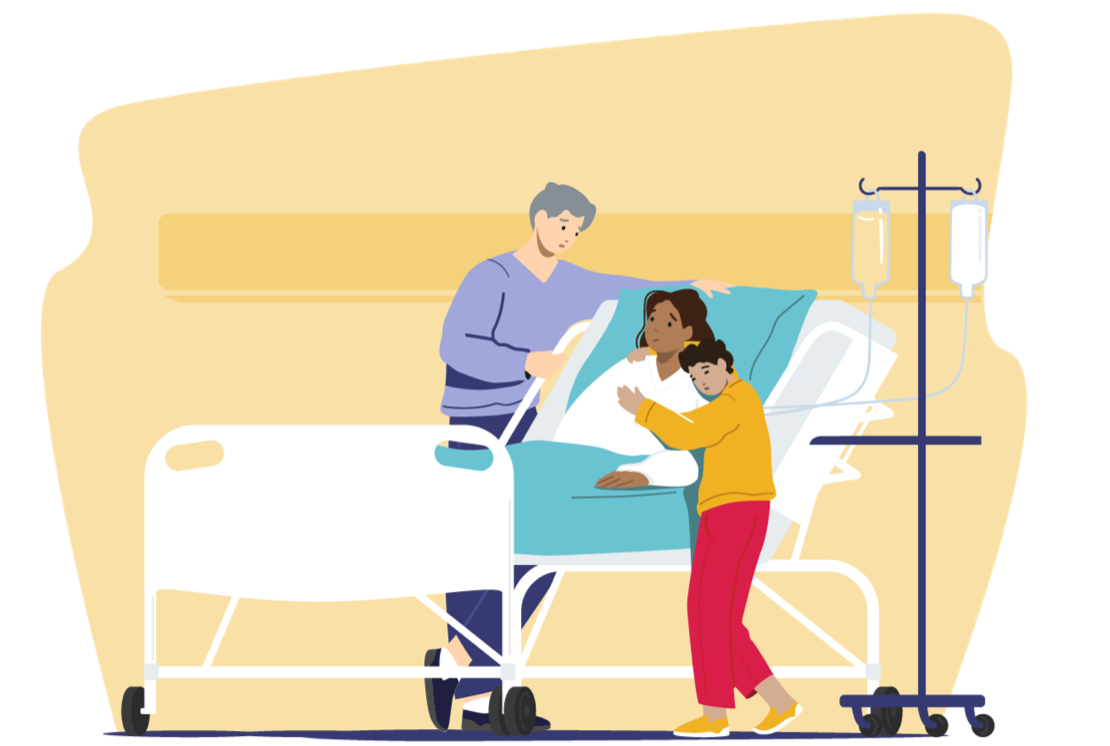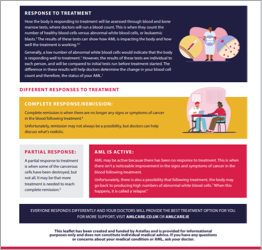Managing Acute Myeloid Leukaemia (AML)
If the initial results from blood and bone marrow tests confirm a diagnosis of Acute Myeloid Leukaemia, doctors will recommend the most appropriate treatment for you to start on.
In-hospital treatment
What happens when you have treatment in hospital? What is a clinical trial? Find the answers to these questions and more.
Treatment at home
How is treatment given? What is a 'day-ward'? Find the answers to these questions and more.
Understanding bone marrow transplant
How are transplants given? Who is offered a transplant? Find the answers to these questions and more.
What is the aim of AML treatment?


Most of the time, the aim of treatment is to put AML into remission.1 Remission is when there are low to no signs and symptoms of acute leukaemia in the blood.1
Essentially, most treatments will try to slow down the production of abnormal white blood cells. Why not watch how this works.1,2
Unfortunately, it may not be possible for all people with AML to go into remission.2 Doctors will discuss treatment options and the possible outcomes associated with each option.

Do all people with AML receive the same treatment?
No, not all treatment plans for people with AML are the same. Doctors consider several things when deciding on the most appropriate treatment. These include:
1. THE SUBTYPE OF AML
Each case of AML is unique.2,3 Even within the same person, the subtype of AML may change over time. This means it is common for people to receive a range of different treatments.2
2. GENERAL FITNESS LEVEL
Some of the treatments for AML can be intense and doctors need to ensure that the body is healthy and fit enough to tolerate them.
3. PERSONAL GOALS
The priority will become AML treatment, however, if you have specific personal goals that are very important to you, be sure to discuss these with your doctor to understand what may be realistic.
Does AML treatment have side effects?
Like many other treatments, people experience side effects while being treated for AML.4 This is to be expected. It is essential to know that just because someone has a side effect, this does not mean that the treatment is not working.
Nurses and doctors are highly skilled at monitoring for treatment side effects. If these do develop, several options are available. Speak to your doctor if you experience any side effects of AML treatment.
Do people have to stay in hospital for AML treatment?
It depends, as every treatment journey is unique. Initial treatment will typically involve four cycles of chemotherapy5 — each cycle of treatment will require staying in the hospital for several weeks. Following this, patients may be able to come to the hospital as a day patient, and go home overnight.
If there are any words or terms you don’t understand, the Terminology Explained document can help guide you.
How do people respond to treatment?
AML is a complicated blood cancer that can sometimes leave people feeling confused, particularly when it comes to discussing the body’s response to treatment. Discussing this in detail with a doctor can help make things clearer. There is a lot of information, and no one can be expected to remember it all, so don’t worry if you are repeating questions!
Why not use the following checklist of questions to take with you to your next clinic. It may help you to understand how you or your loved one’s treatment is working and what the next steps are:
Questions to ask your doctor about living with AML
Other useful information

Treatment response brochure
Download this document to understand how people respond differently to anticancer treatments.
Relapse
Unfortunately, there is a possibility that following treatment, the body may go back to producing high numbers of abnormal white blood cells. When this happens, it is called a ‘relapse’.6
Receiving a diagnosis of relapse can be overwhelming. However, some people find that increasing their medical knowledge can help with this.
Alisdair’s story
Watch this video to hear Alisdair’s thoughts on his time in hospital, and how he managed with a young family at home.

Informative brochure
Find more information about AML relapse in this helpful brochure from Leukaemia Care.
Jane’s story
Jane relapsed three months after achieving remission. Hear her story and what advice she would give others who have relapsed.
Find out more about
In-hospital treatment
What happens when you have treatment in hospital? What is a clinical trial? Find the answers to these questions and more.
Treatment at home
How is treatment given? What is a 'day-ward'? Find the answers to these questions and more
Understanding bone marrow transplant
How are transplants given? Who is offered a transplant? Find the answers to these questions and more
References
1. Saultz JN and Garzon R. Acute Myeloid Leukemia: A Concise Review. J Clin Med 2016; 5 20160305.
2. DiNardo CD and Cortes JE. Mutations in AML: prognostic and therapeutic implications. Hematology Am Soc Hematol Educ Program 2016; 2016: 348-355.
3. Gregory TK, Wald D, Chen Y, et al. Molecular prognostic markers for adult acute myeloid leukemia with normal cytogenetics. J Hematol Oncol 2009; 2: 23. 20090602.
4. Blood Cancer UK. Acute myeloid leukaemia (AML) side effects. https://bloodcancer.org.uk/understanding-blood-cancer/leukaemia/acute-myeloid-leukaemia/aml-treatment-side-effects/aml-treatment-side-effects/ [Last accessed April 2022]
5. Blood Cancer UK. Acute Myeloid Leukemia Treatment phases. https://bloodcancer.org.uk/understanding-blood-cancer/leukaemia/acute-myeloid-leukaemia/aml-treatment-side-effects/aml-treatment-types-phases/ [Last accessed April 2022].
6. Leukaemia Care. Relapse in Acute Myeloid Leukaemia (AML). https://media.leukaemiacare.org.uk/wp-content/uploads/Relapse-in-Acute-Myeloid-Leukaemia-AML-Web-Version.pdf [Last accessed April 2022]
Terminology Explained
Learn and understand the different terminology associated with Acute Myeloid Leukaemia, or AML, in our Terminology Explained guide.
HAE_2022_0005_IE | April 2022

